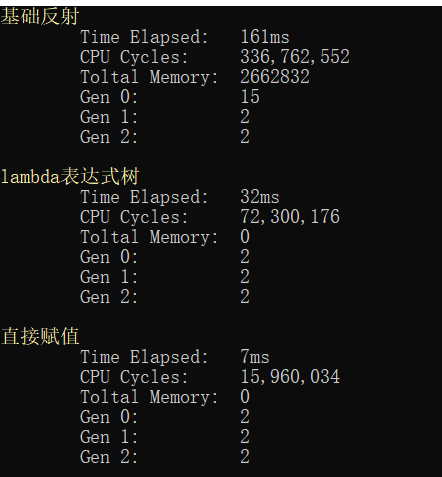жӮЁеҘҪпјҢзҷ»еҪ•еҗҺжүҚиғҪдёӢи®ўеҚ•е“ҰпјҒ
жӮЁеҘҪпјҢзҷ»еҪ•еҗҺжүҚиғҪдёӢи®ўеҚ•е“ҰпјҒ
иҝҷзҜҮж–Үз« дё»иҰҒдёәеӨ§е®¶еұ•зӨәдәҶвҖңеҰӮдҪ•еҲ©з”ЁlambdaиЎЁиҫҫејҸж ‘дјҳеҢ–еҸҚе°„вҖқпјҢеҶ…е®№з®ҖиҖҢжҳ“жҮӮпјҢжқЎзҗҶжё…жҷ°пјҢеёҢжңӣиғҪеӨҹеё®еҠ©еӨ§е®¶и§ЈеҶіз–‘жғ‘пјҢдёӢйқўи®©е°Ҹзј–еёҰйўҶеӨ§е®¶дёҖиө·з ”究并еӯҰд№ дёҖдёӢвҖңеҰӮдҪ•еҲ©з”ЁlambdaиЎЁиҫҫејҸж ‘дјҳеҢ–еҸҚе°„вҖқиҝҷзҜҮж–Үз« еҗ§гҖӮ
еүҚиЁҖ
жң¬иҠӮйҮҚзӮ№дёҚи®ІеҸҚе°„жңәеҲ¶пјҢиҖҢжҳҜи®ІlambdaиЎЁиҫҫејҸж ‘жқҘжӣҝд»ЈеҸҚе°„дёӯеёёз”Ёзҡ„иҺ·еҸ–еұһжҖ§е’Ңж–№жі•пјҢжқҘиҫҫеҲ°зӣёеҗҢзҡ„ж•ҲжһңдҪҶеҚҙжҜ”еҸҚе°„й«ҳж•ҲгҖӮ
жҜҸдёӘдәәйғҪзҹҘйҒ“пјҢз”ЁеҸҚе°„и°ғз”ЁдёҖдёӘж–№жі•жҲ–иҖ…еҜ№еұһжҖ§жү§иЎҢSetValueе’ҢGetValueж“ҚдҪңзҡ„ж—¶еҖҷйғҪдјҡжҜ”зӣҙжҺҘи°ғз”Ёж…ўеҫҲеӨҡпјҢиҝҷе…¶дёӯи®ҫи®ЎеҲ°CLRдёӯеҶ…йғЁзҡ„еӨ„зҗҶпјҢдёҚеҒҡж·ұ究гҖӮ然иҖҢпјҢжҲ‘们еңЁжҹҗдәӣжғ…еҶөдёӢеҸҲж— жі•дёҚдҪҝз”ЁеҸҚе°„пјҢжҜ”еҰӮпјҡеңЁдёҖдёӘORMжЎҶжһ¶дёӯпјҢдҪ иҰҒе°ҶдёҖдёӘDataRowиҪ¬еҢ–дёәдёҖдёӘеҜ№иұЎпјҢдҪҶдҪ еҸҲдёҚжё…жҘҡиҜҘеҜ№иұЎжңүд»Җд№ҲеұһжҖ§пјҢиҝҷж—¶еҖҷдҪ е°ұйңҖиҰҒеҶҷдёҖдёӘйҖҡз”Ёзҡ„жіӣеһӢж–№жі•жқҘеӨ„зҗҶпјҢд»ҘдёӢд»Јз ҒеҶҷеҫ—жңүзӮ№жҒ¶еҝғпјҢдҪҶдёҚеҰЁзўҚзҗҶи§Јж„ҸжҖқ:
//е°ҶDataReaderиҪ¬еҢ–дёәдёҖдёӘеҜ№иұЎ
гҖҖгҖҖгҖҖгҖҖ private static T GetObj<T>(SqliteDataReader reader) where T : class
{
T obj = new T();
PropertyInfo[] pros = obj.GetType().GetProperties();
foreach (PropertyInfo item in pros)
{
try
{
Int32 Index = reader.GetOrdinal(item.Name);
String result = reader.GetString(Index);
if (typeof(String) == item.PropertyType)
{
item.SetValue(obj, result);
continue;
}
if (typeof(DateTime) == item.PropertyType)
{
item.SetValue(obj, Convert.ToDateTime(result));
continue;
}
if (typeof(Boolean) == item.PropertyType)
{
item.SetValue(obj, Convert.ToBoolean(result));
continue;
}
if (typeof(Int32) == item.PropertyType)
{
item.SetValue(obj, Convert.ToInt32(result));
continue;
}
if (typeof(Single) == item.PropertyType)
{
item.SetValue(obj, Convert.ToSingle(result));
continue;
}
if (typeof(Single) == item.PropertyType)
{
item.SetValue(obj, Convert.ToSingle(result));
continue;
}
if (typeof(Double) == item.PropertyType)
{
item.SetValue(obj, Convert.ToDouble(result));
continue;
}
if (typeof(Decimal) == item.PropertyType)
{
item.SetValue(obj, Convert.ToDecimal(result));
continue;
}
if (typeof(Byte) == item.PropertyType)
{
item.SetValue(obj, Convert.ToByte(result));
continue;
}
}
catch (ArgumentOutOfRangeException ex)
{
continue;
}
}
return obj;
}еҜ№дәҺиҝҷз§Қжғ…еҶөпјҢе…¶жү§иЎҢж•ҲзҺҮжҳҜзү№еҲ«дҪҺдёӢзҡ„пјҢе…·дҪ“еӨҡж…ўеңЁдёӢйқўдҫӢеӯҗдјҡеңЁ.Net Coreе№іеҸ°дёҠе’Ң.Net Framework4.0иҝҗиЎҢжөӢиҜ•жЎҲдҫӢ.еҜ№дәҺд»ҘдёҠжҲ‘дёҫдҫӢзҡ„жғ…еҶөпјҢж•ҲзҺҮдёҠжҲ‘们иҝҳеҸҜд»Ҙеҫ—еҲ°жҸҗеҚҮгҖӮдҪҶеҜ№дәҺжғіеңЁиҝҗиЎҢж—¶дҝ®ж”№дёҖдёӢеұһжҖ§зҡ„еҗҚз§°жҲ–е…¶д»–ж“ҚдҪңпјҢеҸҚе°„иҝҳжҳҜдёҖйЎ№зү№еҲ«зҡ„зҘһеҷЁпјҢеӣ жӯӨеңЁжҹҗдәӣжғ…еҶөдёӢеҸҚе°„иҝҳжҳҜж— жі•йҒҝе…Қзҡ„гҖӮ
дҪҶжҳҜеҜ№дәҺеҸӘжҳҜз®ҖеҚ•зҡ„SetValueжҲ–иҖ…GetValueпјҢеҢ…жӢ¬з”ЁеҸҚе°„жһ„йҖ еҮҪж•°пјҢжҲ‘们еҸҜд»ҘжғідёҖдёӘдёӯ继зҡ„ж–№жі•пјҢйӮЈе°ұжҳҜдҪҝз”ЁиЎЁиҫҫејҸж ‘гҖӮеҜ№дәҺдёҚзҗҶи§ЈиЎЁиҫҫејҸж ‘зҡ„пјҢеҸҜд»ҘеҲ°еҫ®иҪҜж–ҮжЎЈжҹҘзңӢпјҢзӮ№еҮ»жҲ‘гҖӮиЎЁиҫҫејҸж ‘еҫҲе®№жҳ“йҖҡиҝҮеҜ№иұЎжЁЎеһӢиЎЁзӨәиЎЁиҫҫејҸпјҢеӣ жӯӨејәзғҲе»әи®®еӯҰд№ гҖӮжҹҘзңӢд»ҘдёӢд»Јз Ғпјҡ
static void Main()
{
Dog dog = new Dog();
PropertyInfo propertyInfo = dog.GetType().GetProperty(nameof(dog.Name)); //иҺ·еҸ–еҜ№иұЎDogзҡ„еұһжҖ§
MethodInfo SetterMethodInfo = propertyInfo.GetSetMethod(); //иҺ·еҸ–еұһжҖ§Nameзҡ„setж–№жі•
ParameterExpression param = Expression.Parameter(typeof(Dog), "param");
Expression GetPropertyValueExp = Expression.Lambda(Expression.Property(param, nameof(dog.Name)), param);
Expression<Func<Dog, String>> GetPropertyValueLambda = (Expression<Func<Dog, String>>)GetPropertyValueExp;
ParameterExpression paramo = Expression.Parameter(typeof(Dog), "param");
ParameterExpression parami = Expression.Parameter(typeof(String), "newvalue");
MethodCallExpression MethodCallSetterOfProperty = Expression.Call(paramo, SetterMethodInfo, parami);
Expression SetPropertyValueExp = Expression.Lambda(MethodCallSetterOfProperty, paramo, parami);
Expression<Action<Dog, String>> SetPropertyValueLambda = (Expression<Action<Dog, String>>)SetPropertyValueExp;
//еҲӣе»әдәҶеұһжҖ§Nameзҡ„Getж–№жі•иЎЁиҫҫејҸе’ҢSetж–№жі•иЎЁиҫҫејҸ,еҪ“然еҸӘжҳҜжңҖз®ҖеҚ•зҡ„
Func<Dog, String> Getter = GetPropertyValueLambda.Compile();
Action<Dog, String> Setter = SetPropertyValueLambda.Compile();
Setter?.Invoke(dog, "WLJ"); //жҲ‘们зҺ°еңЁеҜ№dogиҝҷдёӘеҜ№иұЎзҡ„NameеұһжҖ§иөӢеҖј
String dogName = Getter?.Invoke(dog); //иҺ·еҸ–еұһжҖ§Nameзҡ„еҖј
Console.WriteLine(dogName);
Console.ReadKey();
}
public class Dog
{
public String Name { get; set; }
}д»ҘдёӢд»Јз ҒеҸҜиғҪеҫҲйҡҫзңӢеҫ—жҮӮпјҢдҪҶеҸӘиҰҒзҹҘйҒ“жҲ‘们еҲӣе»әдәҶеұһжҖ§зҡ„GetгҖҒSetиҝҷдёӨдёӘж–№жі•е°ұиЎҢпјҢе…¶з»“жһңжңҖеҗҺд№ҹиғҪиҫ“еҮәзӢ—зҡ„еҗҚеӯ— WLJ,жӢҘжңүExpressionTreeзҡ„еҘҪеӨ„жҳҜд»–жңүдёҖдёӘеҗҚдёәCompileпјҲпјүзҡ„ж–№жі•пјҢе®ғеҲӣе»әдёҖдёӘд»ЈиЎЁиЎЁиҫҫејҸзҡ„д»Јз Ғеқ—гҖӮзҺ°еңЁжҳҜжңҖжңүи¶Јзҡ„йғЁеҲҶпјҢеҒҮи®ҫдҪ еңЁзј–иҜ‘ж—¶дёҚзҹҘйҒ“зұ»еһӢпјҲеңЁиҝҷзҜҮж–Үз« дёӯеҢ…еҗ«зҡ„д»Јз ҒжҲ‘еңЁдёҚеҗҢзҡ„зЁӢеәҸйӣҶдёҠеҲӣе»әдәҶдёҖдёӘзұ»еһӢпјүдҪ д»Қ然еҸҜд»Ҙеә”з”Ёиҝҷз§ҚжҠҖжңҜпјҢжҲ‘е°ҶеҜ№дәҺеёёз”Ёзҡ„еұһжҖ§зҡ„setпјҢgetж“ҚдҪңиҝӣиЎҢеҲҶиЈ…гҖӮ
/// <summary>
гҖҖгҖҖ/// еұһжҖ§зұ»пјҢд»ҝйҖ еҸҚе°„дёӯзҡ„PropertyInfo
/// </summary>
гҖҖгҖҖpublic class Property
{
private readonly PropertyGetter getter;
private readonly PropertySetter setter;
public String Name { get; private set; }
public PropertyInfo Info { get; private set; }
public Property(PropertyInfo propertyInfo)
{
if (propertyInfo == null)
throw new NullReferenceException("еұһжҖ§дёҚиғҪдёәз©ә");
this.Name = propertyInfo.Name;
this.Info = propertyInfo;
if (this.Info.CanRead)
{
this.getter = new PropertyGetter(propertyInfo);
}
if (this.Info.CanWrite)
{
this.setter = new PropertySetter(propertyInfo);
}
}
/// <summary>
гҖҖгҖҖ /// иҺ·еҸ–еҜ№иұЎзҡ„еҖј
/// </summary>
гҖҖгҖҖ/// <param name="instance"></param>
гҖҖгҖҖ/// <returns></returns>
гҖҖгҖҖ public Object GetValue(Object instance)
{
return getter?.Invoke(instance);
}
/// <summary>
гҖҖгҖҖ /// иөӢеҖјж“ҚдҪң
/// </summary>
гҖҖгҖҖ/// <param name="instance"></param>
гҖҖгҖҖ/// <param name="value"></param>
гҖҖгҖҖ public void SetValue(Object instance, Object value)
{
this.setter?.Invoke(instance, value);
}
private static readonly ConcurrentDictionary<Type, Core.Reflection.Property[]> securityCache = new ConcurrentDictionary<Type, Property[]>();
public static Core.Reflection.Property[] GetProperties(Type type)
{
return securityCache.GetOrAdd(type, t => t.GetProperties().Select(p => new Property(p)).ToArray());
}
}
/// <summary>
гҖҖгҖҖ/// еұһжҖ§Getж“ҚдҪңзұ»
/// </summary>
гҖҖгҖҖ public class PropertyGetter
{
private readonly Func<Object, Object> funcGet;
public PropertyGetter(PropertyInfo propertyInfo) : this(propertyInfo?.DeclaringType, propertyInfo.Name)
{
}
public PropertyGetter(Type declareType, String propertyName)
{
if (declareType == null)
{
throw new ArgumentNullException(nameof(declareType));
}
if (propertyName == null)
{
throw new ArgumentNullException(nameof(propertyName));
}
this.funcGet = CreateGetValueDeleagte(declareType, propertyName);
}
//д»Јз Ғж ёеҝғйғЁеҲҶ
гҖҖгҖҖ private static Func<Object, Object> CreateGetValueDeleagte(Type declareType, String propertyName)
{
// (object instance) => (object)((declaringType)instance).propertyName
гҖҖгҖҖгҖҖгҖҖvar param_instance = Expression.Parameter(typeof(Object));
var body_objToType = Expression.Convert(param_instance, declareType);
var body_getTypeProperty = Expression.Property(body_objToType, propertyName);
var body_return = Expression.Convert(body_getTypeProperty, typeof(Object));
return Expression.Lambda<Func<Object, Object>>(body_return, param_instance).Compile();
}
public Object Invoke(Object instance)
{
return this.funcGet?.Invoke(instance);
}
}
гҖҖpublic class PropertySetter
{
private readonly Action<Object, Object> setFunc;
public PropertySetter(PropertyInfo property)
{
if (property == null)
{
throw new ArgumentNullException(nameof(property));
}
this.setFunc = CreateSetValueDelagate(property);
}
private static Action<Object, Object> CreateSetValueDelagate(PropertyInfo property)
{
// (object instance, object value) =>
// ((instanceType)instance).Set_XXX((propertyType)value)
//еЈ°жҳҺж–№жі•йңҖиҰҒзҡ„еҸӮж•°
var param_instance = Expression.Parameter(typeof(Object));
var param_value = Expression.Parameter(typeof(Object));
var body_instance = Expression.Convert(param_instance, property.DeclaringType);
var body_value = Expression.Convert(param_value, property.PropertyType);
var body_call = Expression.Call(body_instance, property.GetSetMethod(), body_value);
return Expression.Lambda<Action<Object, Object>>(body_call, param_instance, param_value).Compile();
}
public void Invoke(Object instance, Object value)
{
this.setFunc?.Invoke(instance, value);
}
}еңЁе°Ҷд»Јз Ғеә”з”ЁеҲ°е®һдҫӢпјҡ
Dog dog = new Dog(); PropertyInfo propertyInfo = dog.GetType().GetProperty(nameof(dog.Name)); //еҸҚе°„ж“ҚдҪң propertyInfo.SetValue(dog, "WLJ"); String result = propertyInfo.GetValue(dog) as String; Console.WriteLine(result); //иЎЁиҫҫејҸж ‘зҡ„ж“ҚдҪң Property property = new Property(propertyInfo); property.SetValue(dog, "WLJ2"); String result2 = propertyInfo.GetValue(dog) as String; Console.WriteLine(result2);
еҸ‘зҺ°е…¶е®һзҺ°зҡ„зӣ®зҡ„дёҺеҸҚе°„дёҖиҮҙпјҢдҪҶж•ҲзҺҮеҚҙжңүжҳҺжҳҫзҡ„жҸҗй«ҳгҖӮ
д»ҘдёӢжөӢиҜ•д»ҘдёӢ他们дёӨд№Ӣй—ҙзҡ„ж•ҲзҺҮгҖӮжөӢиҜ•д»Јз ҒеҰӮдёӢпјҡ
Student student = new Student();
PropertyInfo propertyInfo = student.GetType().GetProperty(nameof(student.Name));
Property ExpProperty = new Property(propertyInfo);
Int32 loopCount = 1000000;
CodeTimer.Initialize(); //жөӢиҜ•зҺҜеўғеҲқе§ӢеҢ–
//дёӢйқўиҜҘж–№жі•дёӘжү§иЎҢ1000000ж¬Ў
CodeTimer.Time("еҹәзЎҖеҸҚе°„", loopCount, () => {
propertyInfo.SetValue(student, "Fode",null);
});
CodeTimer.Time("lambdaиЎЁиҫҫејҸж ‘", loopCount, () => {
ExpProperty.SetValue(student, "Fode");
});
CodeTimer.Time("зӣҙжҺҘиөӢеҖј", loopCount, () => {
student.Name = "Fode";
});
Console.ReadKey();е…¶.Net4.0зҺҜеўғдёӢиҝҗиЎҢз»“жһңеҰӮдёӢпјҡ

.Net CoreзҺҜеўғдёӢиҝҗиЎҢз»“жһңпјҡ

д»Һд»ҘдёҠз»“жһңеҸҜд»ҘзҹҘйҒ“пјҢиҝӯд»ЈеҗҢж ·зҡ„ж¬Ўж•°еҸҚе°„йңҖиҰҒ183msпјҢиҖҢз”ЁиЎЁиҫҫејҸеҸӘиҰҒ34msпјҢзӣҙжҺҘиөӢеҖјйңҖиҰҒ7msпјҢеңЁж•ҲзҺҮдёҠпјҢдҪҝз”ЁиЎЁиҫҫејҸиҝҷз§Қж–№жі•жңүжҳҫи‘—зҡ„жҸҗй«ҳпјҢжӮЁеҸҜд»ҘзңӢеҲ°дҪҝз”ЁжӯӨжҠҖжңҜеҸҜд»Ҙе®Ңе…ЁйҒҝе…ҚдҪҝз”ЁеҸҚе°„ж—¶зҡ„жҖ§иғҪжҚҹеӨұгҖӮеҸҚе°„д№ӢжүҖд»Ҙж•ҲзҺҮжңүзӮ№дҪҺдё»иҰҒеҸ–еҶідәҺе…¶еҠ иҪҪзҡ„ж—¶еҖҷж—¶еңЁиҝҗиЎҢжңҹдёӢпјҢиҖҢиЎЁиҫҫејҸеҲҷеңЁзј–иҜ‘жңҹпјҢдёӢзҜҮжңүз©әе°Ҷдјҡд»Ӣз»Қз”ЁEmitжҠҖжңҜдјҳеҢ–еҸҚе°„пјҢдјҡжҜ”иЎЁиҫҫејҸз•Ҙеҝ«дёҖзӮ№гҖӮ
жіЁпјҡеҜ№дәҺеёёз”ЁеҜ№иұЎзҡ„еұһжҖ§пјҢжңҖеҘҪе°Ҷе…¶зј“еӯҳиө·жқҘпјҢиҝҷж ·ж•ҲзҺҮдјҡжӣҙй«ҳгҖӮгҖӮ
д»ҘдёҠжҳҜвҖңеҰӮдҪ•еҲ©з”ЁlambdaиЎЁиҫҫејҸж ‘дјҳеҢ–еҸҚе°„вҖқиҝҷзҜҮж–Үз« зҡ„жүҖжңүеҶ…е®№пјҢж„ҹи°ўеҗ„дҪҚзҡ„йҳ…иҜ»пјҒзӣёдҝЎеӨ§е®¶йғҪжңүдәҶдёҖе®ҡзҡ„дәҶи§ЈпјҢеёҢжңӣеҲҶдә«зҡ„еҶ…е®№еҜ№еӨ§е®¶жңүжүҖеё®еҠ©пјҢеҰӮжһңиҝҳжғіеӯҰд№ жӣҙеӨҡзҹҘиҜҶпјҢж¬ўиҝҺе…іжіЁдәҝйҖҹдә‘иЎҢдёҡиө„и®Ҝйў‘йҒ“пјҒ
е…ҚиҙЈеЈ°жҳҺпјҡжң¬з«ҷеҸ‘еёғзҡ„еҶ…е®№пјҲеӣҫзүҮгҖҒи§Ҷйў‘е’Ңж–Үеӯ—пјүд»ҘеҺҹеҲӣгҖҒиҪ¬иҪҪе’ҢеҲҶдә«дёәдё»пјҢж–Үз« и§ӮзӮ№дёҚд»ЈиЎЁжң¬зҪ‘з«ҷз«ӢеңәпјҢеҰӮжһңж¶үеҸҠдҫөжқғиҜ·иҒ”зі»з«ҷй•ҝйӮ®з®ұпјҡis@yisu.comиҝӣиЎҢдёҫжҠҘпјҢ并жҸҗдҫӣзӣёе…іиҜҒжҚ®пјҢдёҖз»ҸжҹҘе®һпјҢе°Ҷз«ӢеҲ»еҲ йҷӨж¶үе«ҢдҫөжқғеҶ…е®№гҖӮ